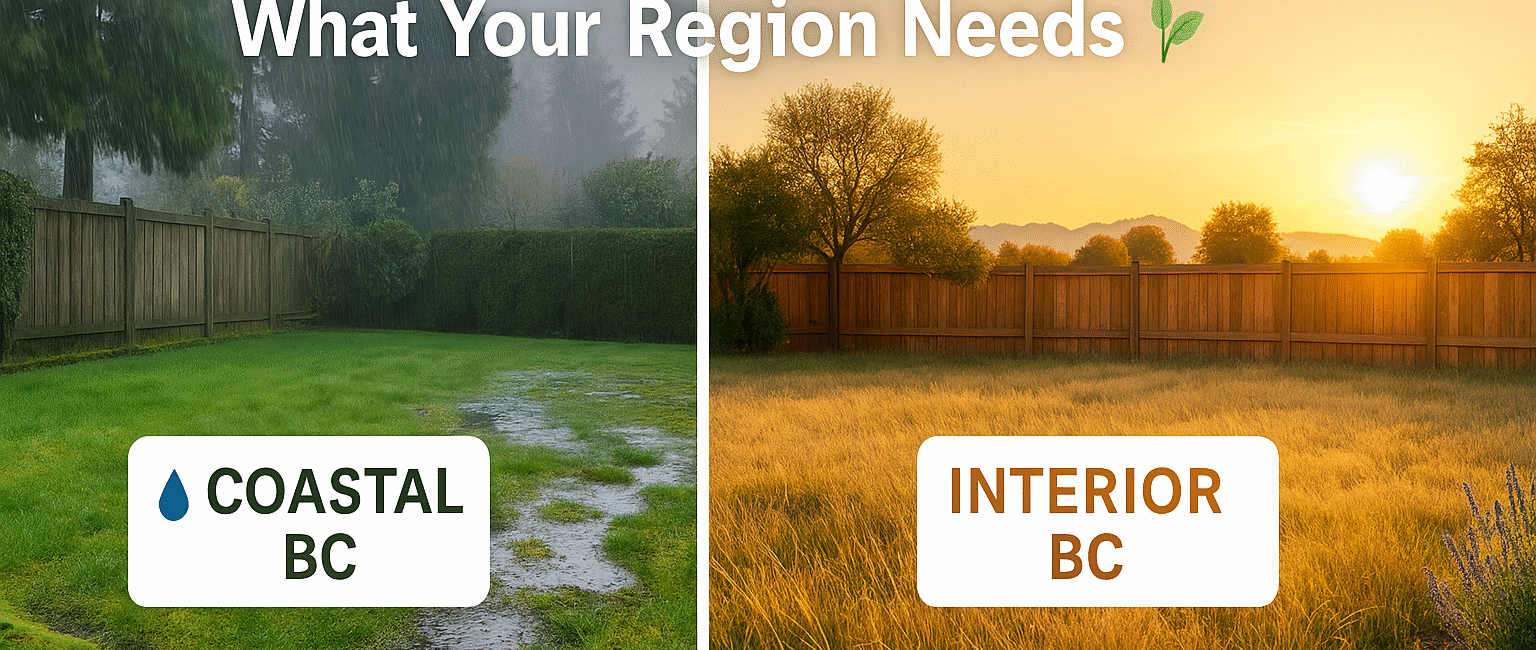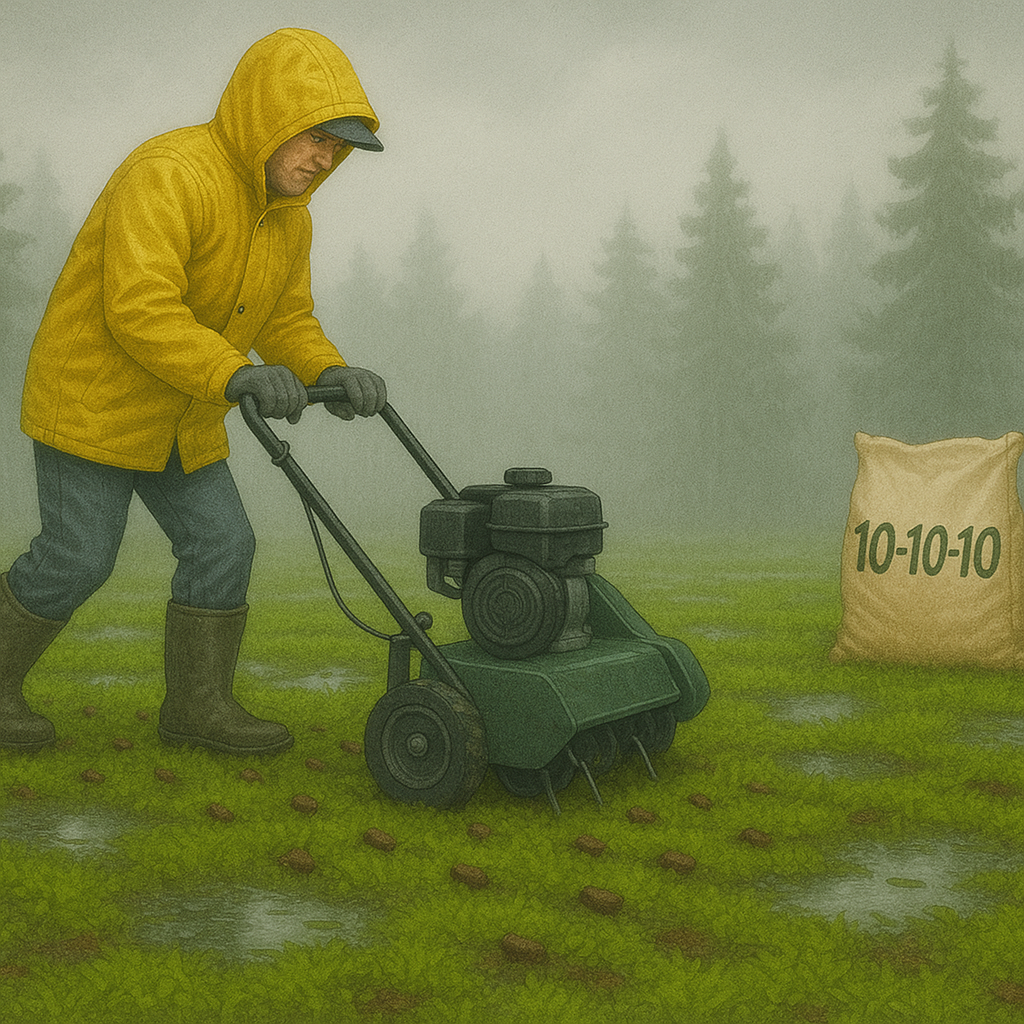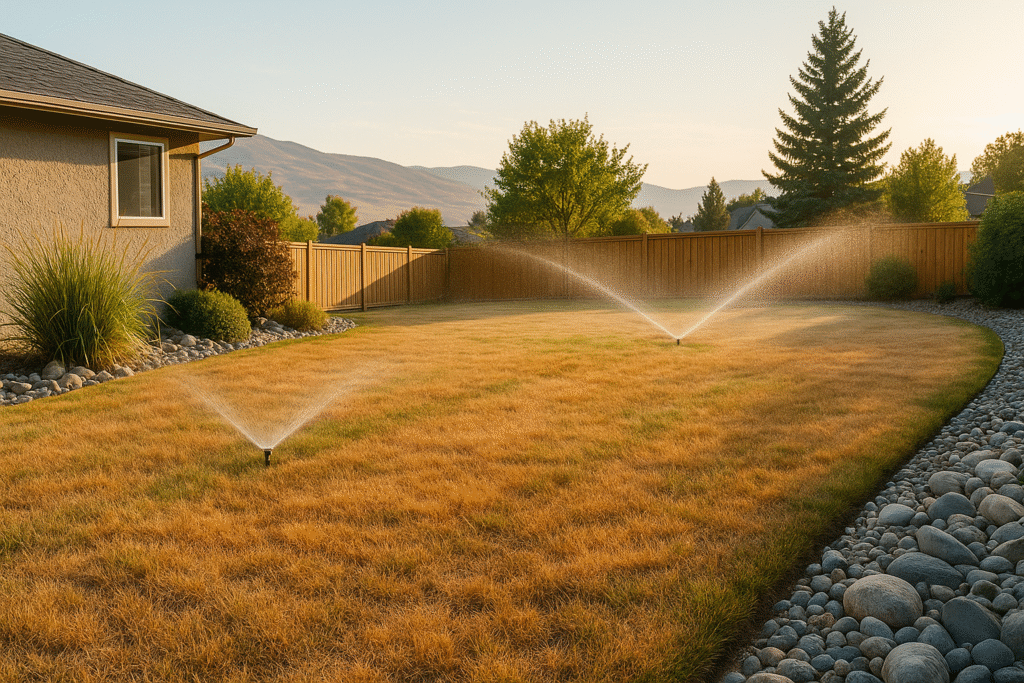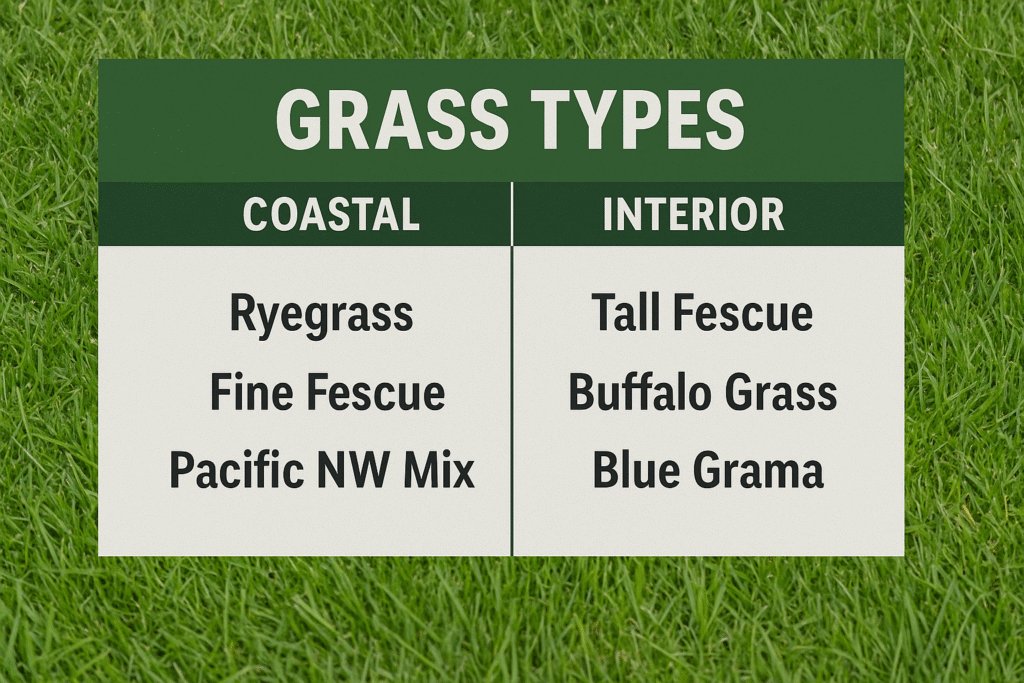
Living in Beautiful British Columbia means dealing with some of Canada’s most diverse climates – and your lawn care routine should reflect that! Whether you’re maintaining a lush green space in rainy Vancouver or battling the dry summers of Kamloops, understanding your local microclimate is the secret to a healthy, thriving lawn.
🌊 Coastal BC Lawn Care: Wet Winters, Mild Summers
The Coastal Climate Challenge
Coastal BC regions like Vancouver, Victoria, Richmond, and Burnaby experience:
- High rainfall (800-1,200mm annually)
- Mild temperatures year-round
- High humidity levels
- Limited summer sun compared to interior regions
✅ Best Practices for Coastal Lawns
Drainage is Everything
Your biggest enemy? Standing water. Coastal BC’s heavy rains can waterlog soil, leading to root rot and fungal diseases. Install proper drainage systems and consider aerating your lawn twice yearly – once in spring and again in fall.
Fungal Disease Prevention 🍄
The wet, humid conditions create perfect breeding grounds for lawn diseases like:
- Red thread
- Fairy ring
- Dollar spot
- Snow mold
Combat these by ensuring good air circulation, avoiding evening watering, and applying preventive fungicides during peak growing season.
Fertilization Strategy
Coastal lawns need less frequent fertilizing due to slower growth rates. Apply a balanced fertilizer (10-10-10) in early spring and mid-summer. Avoid over-fertilizing, which can promote disease in humid conditions.
Mowing Tips for Wet Climates
- Keep grass slightly longer (3+ inches) to improve disease resistance
- Never mow wet grass – wait for dry conditions
- Clean mower blades regularly to prevent disease spread

🏔️ Interior BC Lawn Care: Hot, Dry Summers Meet Cold Winters
The Interior Climate Reality
Interior BC cities like Kelowna, Kamloops, Prince George, and Vernon face:
- Low annual rainfall (300-500mm)
- Extreme temperature swings (hot summers, cold winters)
- Intense UV exposure at higher elevations
- Dry, chinook winds
✅ Best Practices for Interior Lawns
Water Management is Critical 💧
Interior BC lawns require strategic watering:
- Deep, infrequent watering (2-3 times per week)
- Early morning watering (6-8 AM) to reduce evaporation
- 1-1.5 inches per week including rainfall
- Install efficient irrigation systems to combat water restrictions
Heat Stress Prevention
- Choose drought-tolerant grass varieties (fine fescue, buffalo grass)
- Maintain longer grass height (3.5-4 inches) for better root protection
- Apply mulching mowers to retain soil moisture
- Consider overseeding with climate-adapted varieties
Winter Preparation
Interior BC’s harsh winters require special attention:
- Final mow at 2.5 inches before first hard frost
- Fall fertilization with high-potassium fertilizer
- Snow mold prevention by removing leaves and debris
- Dormant oil applications for pest control
Soil Amendments
Interior soils often need help retaining moisture:
- Add compost annually to improve water retention
- Consider clay amendments for sandy soils
- Test soil pH regularly (interior soils tend to be more alkaline)

🌱 Grass Type Recommendations by Region
Coastal BC Champions:
- Perennial Ryegrass – handles moisture well, stays green
- Fine Fescue – low maintenance, disease resistant
- Pacific Northwest Seed Mixes – specially formulated for coastal conditions
Interior BC Winners:
- Tall Fescue – drought tolerant, heat resistant
- Buffalo Grass – minimal water needs
- Blue Grama – native option, extremely hardy

📅 Seasonal Care Calendar
Spring (March-May)
Coastal: Focus on drainage, early fertilization, disease prevention
Interior: Repair winter damage, prepare irrigation, gradual fertilization
Summer (June-August)
Coastal: Maintain consistent moisture, watch for fungal issues
Interior: Deep watering schedule, heat stress management
Fall (September-November)
Coastal: Aerate, overseed, reduce watering frequency
Interior: Winter prep, final fertilization, equipment winterization
Winter (December-February)
Coastal: Minimal maintenance, ensure drainage
Interior: Equipment storage, planning for next season
💡 Pro Tips for Both Regions
Soil Testing is Essential
Get your soil tested every 2-3 years. Coastal soils tend to be acidic, while interior soils lean alkaline. Adjust accordingly with lime or sulfur.
Native Plant Integration
Consider incorporating native BC plants around lawn edges to reduce maintenance and support local ecosystems.
Water-Smart Landscaping
Both regions benefit from xeriscaping principles – using drought-tolerant plants and efficient irrigation.
🔍 Ready to Find Local Lawn Care Experts?
Don’t let BC’s diverse climate challenges overwhelm you! Whether you’re dealing with coastal moss issues or interior drought stress, professional help is just a click away.
Visit BCServiceFinder.ca today to get matched with experienced, local lawn care professionals who understand your specific regional needs. From Vancouver to Vernon, find trusted experts who know exactly how to keep your lawn healthy in BC’s unique climate conditions.
Get your FREE quotes now and transform your lawn care routine with local knowledge and professional expertise!
❓ Frequently Asked Questions
How often should I water my lawn in coastal BC vs interior BC?
Coastal BC lawns typically need less frequent watering due to higher rainfall – maybe 1-2 times per week during dry spells. Interior BC lawns require more consistent watering, 2-3 times per week with deeper soaking to combat the dry climate.
What’s the best grass seed for BC lawn care regions?
For coastal areas, perennial ryegrass and fine fescue work well. Interior regions benefit from drought-tolerant options like tall fescue or buffalo grass. Always choose seed mixes specifically designed for your local climate zone.
When should I fertilize my lawn in different BC regions?
Coastal lawns need fertilization in early spring (March) and mid-summer (July). Interior lawns benefit from spring fertilization (April), summer feeding (June), and fall application (September) to prepare for harsh winters.
How do I prevent lawn diseases in coastal BC’s wet climate?
Ensure proper drainage, avoid evening watering, maintain good air circulation by not cutting grass too short, and apply preventive fungicides during peak growing season. Regular aeration also helps prevent waterlogged conditions.
What’s the biggest difference between coastal and interior BC lawn care?
Water management is the key difference. Coastal regions focus on drainage and preventing too much moisture, while interior regions concentrate on water conservation and drought protection. Interior lawns also need more winter preparation due to harsh temperature swings.
Found this guide helpful? 📢 Please share it with your friends on Facebook so they can make better decisions about their BC lawn care too! Your neighbors will thank you for helping them achieve the perfect lawn for their specific climate zone.


